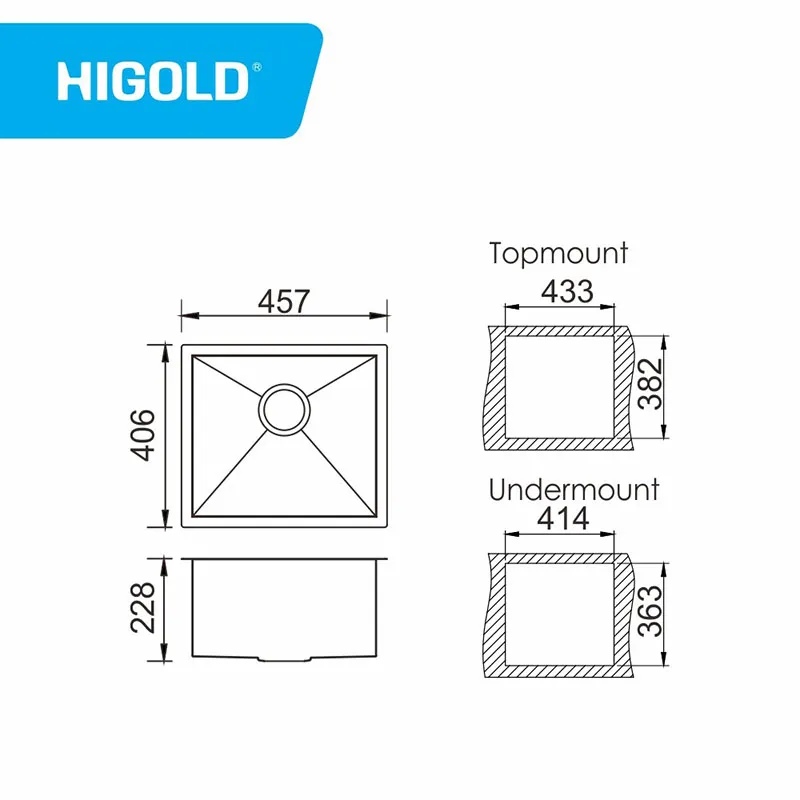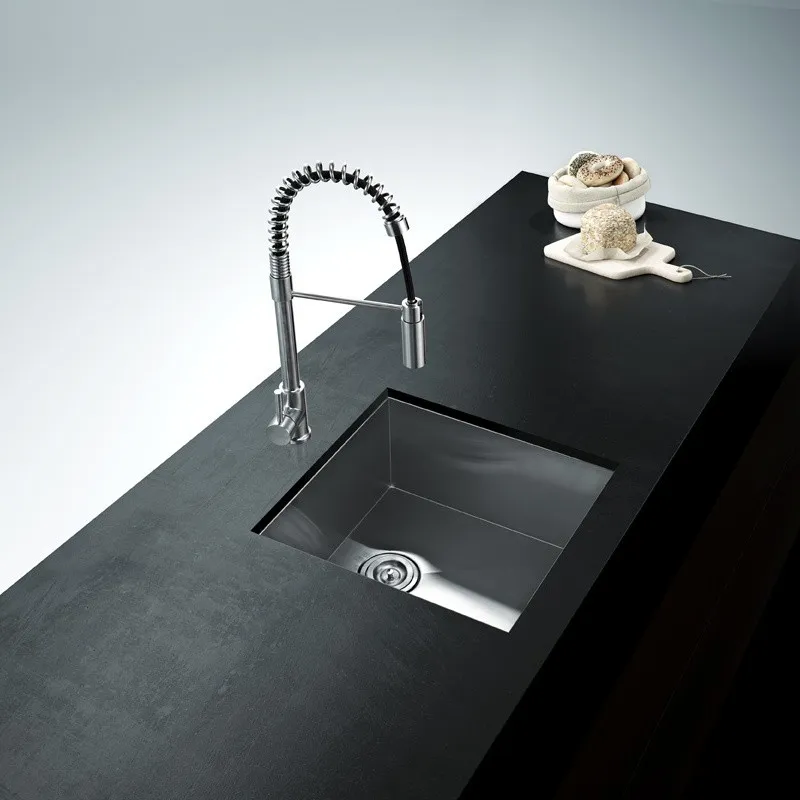The installation method of undermount sink not only makes the kitchen look neater and simpler, but also avoids the accumulation of stains on the edge of the sink, which is convenient for daily cleaning. However, choosing the most suitable kitchen sink for under-counter installation is not a simple matter. Different sink materials, designs, sizes, depths, etc. may affect the installation effect and use experience of undermount sink.
This article will deeply analyze the types of sinks suitable for under-counter installation to help consumers choose the right kitchen sink to ensure the beauty, practicality and durability after under-counter installation.

What is an undermount sink?
Undermount sink, also known as under-mount sink, means that the sink is installed under the kitchen countertop instead of above the countertop. Compared with the traditional above-counter sink, the edge of the undermount sink is flush with the countertop, and the edge of the sink has no protrusions, forming an integral part with the countertop. This design has the following significant advantages:
● Beautiful and neat: The undermount sink has no protruding edges, making the entire kitchen countertop look more concise and clean, especially suitable for modern and minimalist kitchen design.
● Easy to clean: Since the sink is flush with the countertop, dirt will not accumulate on the edge of the sink, making it easier to clean and avoiding the situation where the countertop sink is prone to accumulate scale and oil stains.
● Increase countertop space: Due to its edgeless design, the undermount sink does not occupy countertop space, making the kitchen operation area more spacious.
● Water stain resistance: Since the undermount sink has a non-protruding edge, water will not flow along the edge to the countertop when it flows into the sink, avoiding water stains and stains on the countertop.
However, the installation of the undermount sink has high requirements for the kitchen countertop, and the cleanliness of the countertop edge and the firm installation of the sink must be ensured. Therefore, the undermount sink is suitable for matching with solid countertop materials such as quartz stone, stainless steel, etc. Choosing the right sink material and size is the key to ensuring the success of the undermount installation.

What are the materials of kitchen sinks suitable for undermount installation?
Different sink materials will not only affect their durability, appearance and cleaning difficulty, but also affect the matching of the sink and the countertop. When choosing an undermount sink, the choice of material is particularly important. Common sink materials suitable for under-counter installation mainly include stainless steel, quartz, ceramic and composite materials.
1. Stainless steel kitchen sink
Stainless steel kitchen sink is one of the most common kitchen sink materials and has many advantages, making it suitable for under-counter installation. Its durability, corrosion resistance, stain resistance and easy cleaning make it an ideal choice for undermount sinks.
Advantages of stainless steel kitchen sink:
● Strong durability: Stainless steel undermount sinks have strong impact and scratch resistance, which is very suitable for busy kitchen environments.
● Easy to clean: The surface of stainless steel is smooth and not easy to accumulate scale. Stains and scale can be easily wiped off, which is suitable for under-counter installation and reduces the difficulty of cleaning the edge of the sink.
● Waterproof and anti-penetration: The material of stainless steel does not absorb water, which prevents water from seeping into the countertop from the edge of the sink, ensuring that the countertop remains dry.
Disadvantages of stainless steel kitchen sink:
● Easy to leave scratches: Although stainless steel is very durable, it is still easy to leave subtle scratches and fingerprints during long-term use.
● Sound problem: When water flows into a stainless steel kitchen sink, it may produce a loud sound, especially when washing heavy objects.
2. Quartz kitchen sink
Quartz kitchen sink is made of a combination of quartz sand and resin, and has extremely high hardness and durability. Due to its smooth surface, scratch resistance, high temperature resistance, and corrosion resistance, it has become a very suitable sink material for under-counter installation.
Advantages of quartz kitchen sink:
● Beautiful and elegant: The color and texture of quartz undermount sinks are very high-end, and can be matched with various kitchen countertop materials, especially suitable for modern and luxurious kitchen designs.
● Strong durability: Quartz kitchen sinks have high hardness, are not easy to scratch, and the surface is not easily scratched or worn, suitable for long-term use.
● Good anti-permeability: The surface of quartz is dense, which can effectively prevent water penetration and keep the countertop dry.
● Strong anti-fouling ability: The surface of quartz is smooth and not easy to absorb oil stains and scale, making it very convenient to clean.
Disadvantages of quartz kitchen sink:
● High price: The price of quartz sink is relatively expensive and may not be suitable for consumers with limited budget.
● Heavy weight: Quartz sink is heavy, so you need to ensure that the countertop has sufficient load-bearing capacity when installing it.
3. Ceramic kitchen sink
Ceramic kitchen sink still has a place in many families with its classic white appearance, high temperature resistance, and easy cleaning. The surface of ceramic kitchen sink is smooth and not easy to absorb stains, which is suitable for use with under-counter installation.
Advantages of ceramic kitchen sink:
● Beautiful and durable: The surface of ceramic undermount sink is as smooth as new, with bright color, which can be coordinated with a variety of kitchen styles.
● Strong anti-fouling ability: The surface of ceramic is smooth and not easy to absorb oil stains and stains, which is very simple to clean.
● High temperature resistance and strong acid and alkali resistance: Ceramics have good high temperature resistance, can withstand high temperature and acid and alkali substances, and are not easily damaged.
Disadvantages of ceramic kitchen sinks:
● Easy to break: Although the surface of ceramic kitchen sinks is smooth, they are easy to break when they collide or drop heavy objects, so special care is required.
● Heavy weight: Ceramic undermount sinks are usually heavy, and the support capacity of the countertop needs to be ensured during installation.
4. Composite kitchen sinks
Composite kitchen sinks are usually made of a mixture of natural minerals and acrylic resins. They have the advantages of quartz stone and are lightweight, making them suitable for under-counter installation.
Advantages of composite sinks:
● Good durability: Composite sinks usually have strong resistance to impact, scratches and high temperatures, and are suitable for high-frequency kitchen use.
● Easy to clean: The surface is smooth, stains are not easy to adhere, and it is very convenient to clean.
● Various colors: Composite sinks come in a variety of colors and styles, and can be selected according to the overall style of the kitchen.
Disadvantages of composite sinks:
● May fade: Some low-quality composite sinks may fade over time.
● Not cheap: High-quality composite sinks are more expensive, which may increase the budget for kitchen decoration.

What should you consider when choosing a sink suitable for under-counter installation?
In addition to the kitchen sink material, when choosing a sink suitable for under-counter installation, you also need to consider the following important factors:
1. Compatibility of countertop materials
The installation method of undermount sinks has high requirements for countertop materials. The ideal countertop material should have sufficient strength and stability to ensure that the sink is firmly installed. At the same time, the countertop material should have good waterproof performance to prevent water from penetrating the countertop. Common countertop materials suitable for undermount sinks include quartz, marble, granite and other strong and waterproof materials.
2. The size and shape of the sink
The size and shape of the kitchen sink directly determine the effect of the under-counter installation. When choosing, you need to determine the appropriate sink size based on the specific area of the kitchen, the countertop space and the usage requirements. Usually, the size of the undermount sink will be slightly larger than the opening size of the countertop to ensure that the sink can be firmly installed under the countertop.
3. Installation process
The installation of the undermount sink requires special attention to the process details. During installation, the sealing between the sink and the countertop must be ensured to prevent water from leaking under the countertop. Before installation, it is recommended to consult a professional installer to ensure that the installation process is correct to avoid problems such as water leakage.
4. Cleaning and maintenance
Although undermount sinks have certain advantages in cleaning, they still require regular maintenance to keep them in good condition. For example, ceramic undermount sinks and composite sinks may be subject to strong impact or scratches. Keeping them clean and avoiding the use of strong acid and alkali cleaners can extend the service life of the sink.

How Can I Get a Quote for Bulk Orders of Higold Kitchen Products?
At Higold, we provide competitive pricing for bulk orders of our high-quality kitchen sinks and faucets. Our extensive range of products, including customized solutions, can be tailored to meet your business needs. Whether you're looking to supply premium kitchen products or purchase in bulk, we offer discounts and promotions on large orders. Simply contact us for a detailed quote, and our team will ensure you receive the best prices without compromising on quality.


